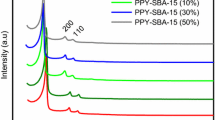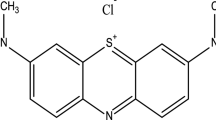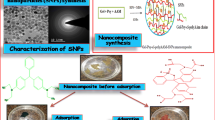Abstract
This work focuses on the preparation of highly hydrophilic polyvinyl alcohol/SBA-15 composites by impregnation method. In order to study the effect of polyvinyl alcohol (PVA) on the structural, textural properties of composites, several percentages of PVA were impregnated into the surface of the mesoporous silica SBA-15. The obtained composites were characterized by different physicochemical techniques such as X-ray diffraction (XRD), Fourier transform infrared spectroscopy (FTIR), nitrogen adsorption-desorption at 77 K adsorption–desorption at 77 K, thermogravimetric analysis (TGA) and scanning electronic microscopy (SEM). The obtained results showed that the structure of SBA-15 was swollen after PVA impregnation, confirming the dispersion of PVA inside the pores. The higher percentages of PVA lead to the decrease in the lattice parameter which results in the formation of PVA aggregates outside the surface. TGA analysis has shown improvement in the hydrophilic character of resulting composite, and this affinity via the water molecules is the result of the increase in number of –OH groups. The obtained composites were used for the adsorption of methylene blue (MB) dye. Effects of contact time, PVA content, adsorbent mass and initial dye concentration were investigated and discussed in terms of adsorption capacity. The experimental data were fitted by pseudo-first-order and pseudo-second-order models and verified by the Langmuir and Freundlich isotherms. The results showed that the adsorption of MB dye on composites followed Langmuir adsorption isotherm models and pseudo-second-order kinetics. The best adsorption capacity of MB dye recorded is ~ 77 mg/g for composite PVA/SBA-15(30%).












Similar content being viewed by others
References
Schweitzer L, Noblet J (2018) Chapter 3.6—Water contamination and pollution. Green Chem 1:261–290. https://doi.org/10.1016/B978-0-12-809270-5.00011-X
Vikrant K, Giri BS, Raza N, Roy K, Kim KH, Nath Rai B, Singh RS (2018) Recent advancements in bioremediation of dye: current status and challenges. Bioresour Technol 253:355–367
Rawat D, Mishra V, Sharma RS (2016) Detoxification of azo dyes in the context of environmental processes. Chemosphere 155:591–605
Wainwright M (2017) The problem with dyes in infection control. Dyes Pigm 146:402–407
Jiao J, Wang J, Li M, Li J, Li Q, Quan Q, Chen J (2016) Simultaneous determination of three azo dyes in food product by ion mobility spectrometry. J Chromatogr B 1025:105–109
Zhu J, Deng C, Jiang H, Zheng Z, Gong R, Bi Y, Zhang L, Lin R (2016) The impact of fluorescent dyes on the performances of polystyrene-based plastic scintillators. Nucl Instrum Methods Phys Res Sect A 835:136–141
Burnier P, Niddam J, Bosc R, Hersant B, Meningaud JP (2017) Indocyanine green applications in plastic surgery: a review of the literature. J Plast Reconstr Aesthet Surg 70:814–827
Shindy HA (2017) Fundamentals in the chemistry of cyanine dyes: a review. Dyes Pigment 145:505–513
Ritter EE, Dickinson ME, Harron JP, Lunderberg DM, DeYoung PA, Robel AE, Field JA, Peaslee GF (2017) PIGE as a screening tool for per-and polyfluorinated substances in papers and textiles. Nucl Instrum Methods Phys Res Sect B 407:47–54
Hamoud HI, Finqueneisel G, Azambre B (2017) Removal of binary dyes mixtures with opposite and similar charges by adsorption, coagulation/flocculation and catalytic oxidation in the presence of CeO2/H2O2 Fenton-like system. J Environ Manag 195:195–207
Kessouri A, Boukoussa B, Bengueddach A, Hamacha R (2018) Synthesis of iron-MFI zeolite and its photocatalytic application for hydroxylation of phenol. Res Chem Intermed 44:2475–2487
Bellatreche S, Hasnaoui A, Boukoussa B, García-Aguilar J, Berenguer-Murcia Á, Cazorla-Amoros D, Bengueddach A (2016) Structural and textural features of TiO2/SAPO-34 nanocomposite prepared by the sol–gel method. Res Chem Intermed 42:8039–8053
Hameed BB, Ismail ZZ (2018) Decolorization, biodegradation and detoxification of reactive red azo dye using non-adapted immobilized mixed cells. Biochem Eng J 137:71–77
Li J, Gong JL, Zeng GM, Zhang P, Song B, Cao WC, Liu HY, Huan SY (2018) Zirconium-based metal organic frameworks loaded on polyurethane foam membrane for simultaneous removal of dyes with different charges. J Colloid Interface Sci 527:267–279
Hassani KE, Kalnina D, Turks M, Beakou BH, Anouar A (2019) Enhanced degradation of an azo dye by catalytic ozonation over Ni-containing layered double hydroxide nanocatalyst. Sep Purif Technol 210:764–774
Nidheesh PV, Zhou M, Oturan MA (2018) An overview on the removal of synthetic dyes from water by electrochemical advanced oxidation processes. Chemosphere 197:210–227
Hassan MM, Carr CM (2018) A critical review on recent advancements of the removal of reactive dyes from dyehouse effluent by ion-exchange adsorbents. Chemosphere 209:201–219
Hussain I, Li Y, Qi J, Li J, Wang L (2018) Nitrogen-enriched carbon sheet for Methyl blue dye adsorption. J Environ Manag 215:123–131
Hamza W, Dammak N, Bel Hadjltaief H, Eloussaief M, Benzina M (2018) Sono-assisted adsorption of cristal violet dye onto Tunisian smectite clay: characterization, kinetics and adsorption isotherms. Ecotoxicol Environ Saf 163:365–371
Fardjaoui NEH, El Berrichi FZ, Ayari F (2017) Kaolin-issued zeolite A as efficient adsorbent for bezanyl yellow and nylomine green anionic dyes. Microporous Mesoporous Mater 243:91–101
Boukoussa B, Hamacha R, Morsli A, Bengueddach A (2017) Adsorption of yellow dye on calcined or uncalcined Al-MCM-41 mesoporous materials. Arab J Chem 10:S2160–S2169
Boukoussa B, Hakiki A, Moulai S, Chikh K, Kherroub DE, Bouhadjar L, Guedal D, Messaoudi K, Mokhtar F, Hamacha R (2018) Adsorption behaviors of cationic and anionic dyes from aqueous solution on nanocomposite polypyrrole/SBA-15. J Mater Sci 53:7372–7386. https://doi.org/10.1007/s10853-018-2060-7
Benhamou A, Baudu M, Derriche Z, Basly JP (2009) Aqueous heavy metals removal on amine-functionalized Si-MCM-41 and Si-MCM-48. J Hazard Mater 171:1001–1008
Benhamou A, Basly JP, Baudu M, Derriche Z, Hamacha R (2013) Amino-functionalized MCM-41 and MCM-48 for the removal of chromate and arsenate. J Colloid Interface Sci 404:135–139
Boukoussa B, Hakiki A, Nunes-Beltrao AP, Hamacha R, Azzouz A (2018) Assessment of the intrinsic interactions of nanocomposite polyaniline/SBA-15 with carbon dioxide: correlation between the hydrophilic character and surface basicity. J CO2 Util 26:171–178
Boukoussa B, Zeghada S, Bentabed Ababsa G, Hamacha R, Derdour A, Bengueddach A, Mongin F (2015) Catalytic behavior of surfactant-containing-MCM-41 mesoporous materials for cycloaddition of 4-nitrophenyl azide. Appl Catal A 489:131–139
Ouargli-Saker R, Bouazizi N, Boukoussa B, Barrimo D, Nunes-Beltrao AP, Azzouz A (2017) Metal-loaded SBA-16-like silica—Correlation between basicity and affinity towards hydrogen. Appl Surf Sci 411:476–486
Ghomari K, Boukoussa B, Hamacha R, Bengueddach A, Roy R, Azzouz A (2017) Preparation of dendrimer polyol/mesoporous silica nanocomposite for reversible CO2 adsorption: effect of pore size and polyol content. Sep Sci Technol 52:2421–2428
Boukoussa B, Kibou Z, Abid Z, Ouargli R, Choukchou-Braham N, Villemin D, Bengueddach A, Hamacha R (2018) Key factor affecting the basicity of mesoporous silicas MCM-41: effect of surfactant extraction time and Si/Al ratio. Chem Pap 72:289–299
Sekkiou H, Boukoussa B, Ghezini R, Khenchoul Z, Ouali A, Hamacha R, Bengueddach A (2016) Enhanced hydrogen storage capacity of copper containing mesoporous silicas prepared using different methods. Mater Res Express 3:085501
Hakiki A, Boukoussa B, Habib Zahmani H, Hamacha R, Hadj Abdelkader NEH, Bekkar F, Bettahar F, Nunes-Beltrao AP, Hacini S, Bengueddach A, Azzouz A (2018) Synthesis and characterization of mesoporous silica SBA-15 functionalized by mono-, di-, and tri-amine and its catalytic behavior towards Michael addition. Mater Chem Phys 212:415–425
Wang J, Ge H, Bao W (2015) Synthesis and characteristics of SBA-15 with thick pore wall and high hydrothermal stability. Mater Lett 145:312–315
Peng K, Li X, Liu X, Wang Y (2017) Hydrothermally stable Nb-SBA-15 catalysts applied in carbohydrate conversion to 5-hydroxymethyl furfural. Mol Catal 441:72–80
Talha Z, Bachir C, Ziri S, Bellahouel S, Bengueddach A, Villièras F, Pelletier M, Weidler PG, Hamacha R (2017) Al-Rich ordered mesoporous silica SBA-15 materials: synthesis, surface characterization and acid properties. Catal Lett 147:2116–2126
Arica TA, Ayas E, Yakup Arica M (2017) Magnetic MCM-41 silica particles grafted with poly(glycidylmethacrylate) brush: modification and application for removal of direct dyes. Microporous Mesoporous Mater 243:164–175
Kumar Mahto T, Chandra S, Haldar C, Kumar Sahu S (2015) Kinetic and thermodynamic study of polyaniline functionalized magnetic mesoporous silica for magnetic field guided dye adsorption. RSC Adv 5:47909–47919
Gao Q, Zhu H, Luo WJ, Wang S, Zhou CG (2014) Preparation, characterization, and adsorption evaluation of chitosan-functionalized mesoporous composites. Microporous Mesoporous Mater 193:15–26
Mirzaie M, Rashidi A, Tayebi HA, Yazdanshenas ME (2017) Removal of anionic dye from aqueous media by adsorption onto SBA-15/polyamidoamine dendrimer hybrid: adsorption equilibrium and kinetics. J Chem Eng Data 62:1365–1376
Hadizade G, Binaeian E, Sarmasti Emami MR (2017) Preparation and characterization of hexagonal mesoporous silica/polyacrylamide nanocomposite capsule (PAM-HMS) for dye removal from aqueous solutions. J Mol Liq 238:499–507
Sharma A, Dubey A (2017) Surface modified mesoporous silica polymer nanocomposites for adsorption of dyes from aqueous solution. J Porous Mater 24:429–435
Zhao D, Huo Q, Feng J, Chmelka BF, Stucky GD (1998) Nonionic triblock and star diblock copolymer and oligomeric surfactant syntheses of highly ordered, hydrothermally stable, mesoporous silica structures. J Am Chem Soc 120:6024–6036
Qi X, Hu X, Wei W, Yu H, Li J, Zhang J, Dong W (2015) Investigation of salecan/poly(vinyl alcohol) hydrogels prepared by freeze/thaw method. Carbohyd Polym 118:60–69
Wang LY, Wang MJ (2016) Removal of heavy metal ions by poly(vinyl alcohol) and carboxymethyl cellulose composite hydrogels prepared by a freeze–thaw method. ACS Sustain Chem Eng 4:2830–2837
Sing KSW, Everett DH, Haul RAW, Moscou L, Pierotti RA, Rouquerol J, Siemieniewska T (1985) Reporting physisorption data for gas/solid systems with special reference to the determination of surface area and porosity. Pure Appl Chem 57:603–619
Abd El-Hafiz DR, Riad M, Mikhail S (2015) Nano-structured Mn–Al and Co–Al oxide materials for catalytic ethanol conversion. J Nanostruct Chem 5:393–403
Parlayici S, Eskizeybek V, Avcı A, Pehlivan E (2015) Removal of chromium (VI) using activated carbon-supported-functionalized carbon nanotubes. J Nanostruct Chem 5:255–263
Li Y, Zhou K, He M, Yao J (2016) Synthesis of ZIF-8 and ZIF-67 using mixed-base and their dye adsorption. Microporous Mesoporous Mater 234:287–292
Wang S, Zhu ZH (2006) Characterisation and environmental application of an Australian natural zeolite for basic dye removal from aqueous solution. J Hazard Mater 136:946–952
Wu T, Cai X, Tan S, Li H, Liu J, Yang W (2011) Adsorption characteristics of acrylonitrile, P-Toluenesulfonic acid, 1-naphthalenesulfonic acid and methyl blue on graphene in aqueous solutions. Chem Eng J 173:144–149
Yao Y, Xu F, Chen M, Xu Z, Zhu Z (2010) Adsorption behavior of methylene blue on carbon nanotubes. Biores Technol 101:3040–3046
Zhao M, Tang Z, Liu P (2008) Removal of methylene blue from aqueous solution with silica nano-sheets derived from vermiculite. J Hazard Mater 158:43–51
Liu J, Hartono SB, Jin YG, Li Z, Lu GQM, Qiao SZ (2010) A facile vesicle template route to multi-shelled mesoporous silica hollow nanospheres. J Mater Chem 20:4595–4601
Monash P, Pugazhenthi G (2010) Investigation of equilibrium and kinetic parameters of methylene blue adsorption onto MCM-41. Korean J Chem Eng 27:1184–1191
Lin LD, Lin Y, Li CJ, Wu DY, Kong HN (2016) Synthesis of zeolite/hydrous metal oxide composites from coal fly ash as efficient adsorbents for removal of methylene blue from water. Int J Miner Process 148:32–40
Author information
Authors and Affiliations
Corresponding author
Ethics declarations
Conflict of interest
The authors declare that they have no conflict of interest.
Additional information
Publisher's Note
Springer Nature remains neutral with regard to jurisdictional claims in published maps and institutional affiliations.
Electronic supplementary material
Below is the link to the electronic supplementary material.
Rights and permissions
About this article
Cite this article
Abid, Z., Hakiki, A., Boukoussa, B. et al. Preparation of highly hydrophilic PVA/SBA-15 composite materials and their adsorption behavior toward cationic dye: effect of PVA content. J Mater Sci 54, 7679–7691 (2019). https://doi.org/10.1007/s10853-019-03415-w
Received:
Accepted:
Published:
Issue Date:
DOI: https://doi.org/10.1007/s10853-019-03415-w




